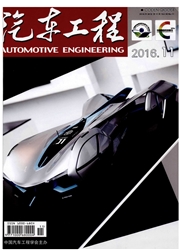

 中文摘要:
中文摘要:
本文围绕ISG型混合动力汽车起动工况,研究了冷却水温和拖动转速对发动机起动阻力矩、电机电流特性和系统转速特性的影响。结果显示:冷却水温对电机拖动策略及起动性能有重要影响,当冷却水温低于约45℃时,发动机平均起动阻力矩随温度升高而明显降低,且拖动转速的升高对平均起动阻力矩的影响较为明显;而当冷却水温高于约45℃后平均起动阻力矩变化平缓;从降低阻力矩的角度出发,应采用低速起动。转矩控制模式下,热机和低速起动时,起动瞬间电机电流出现较大畸变,适当提高拖动转速或降低起动转矩有利于减小起动瞬间的冲击电流;转速控制模式下,起动瞬间产生更大的冲击电流,提高拖动转速有利于减小起动初期电机电流的突变。为实现快速起动,应根据冷却水温确定电机的起动控制策略,冷却水温高于约45℃时,采用转矩控制模式,低于约45℃时,采用转速控制模式。
 英文摘要:
英文摘要:
In this paper,the effects of coolant temperature and cranking speed on the starting resistance moment of engine,the current characteristics of electric motor and the speed characteristics of system for an ISG hybrid electric vehicle under starting condition are studied. The results indicate that the coolant temperature has an important effect on the motor cranking strategy and starting performance. When coolant temperature is below around45℃,the average starting resistance moment significantly reduces with the rise of coolant temperature,and obviously decreases with the fall in cranking speed,and when the coolant temperature is higher than around 45℃,the average starting resistance moment tends to be stable. From a point of view of reducing resistance moment,low speed starting should be adopted. Under torque control mode,the transient current of motor shows a larger distortion in low- speed and hot start,but the reasonably increasing cranking speed or decreasing starting torque are conducive to the reduction of transient starting current surges; while under speed control mode,larger crrent surge appears in starting instant,and the increase of cranking speed helps reduce the abrupt change of motor current in the initiate phase of starting. For achieving quick start,the starting control strategy of motor should be determined according to coolant temperature: torque control mode should be adopted when coolant temperature is above 45℃,and speed control mode for coolant temperature below 45℃.
 同期刊论文项目
同期刊论文项目
 同项目期刊论文
同项目期刊论文
 期刊信息
期刊信息
